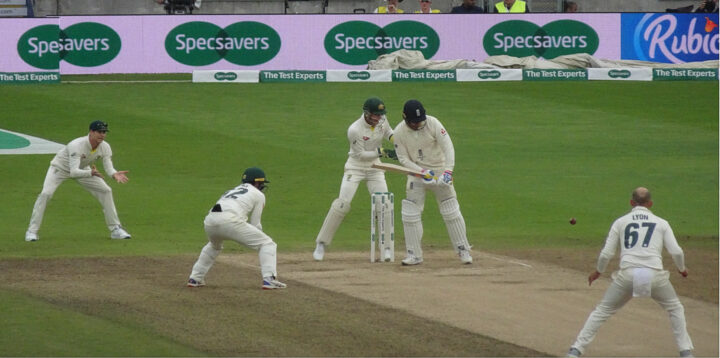Mitchell Johnson’s re-birth was far from our only headache as the calamitous events unfolded in Australia over the winter. Just as damaging was the decline in potency of our own pacemen, Broad excepted, in stark counterpoint to Mitch’s reinvention. As he blossomed, James Anderson wilted. But what best explains their inverse fortunes?
Maybe we should ask a proper fast bowler. And that’s exactly what we’ve done. In this guest post for The Full Toss, former Somerset, Northamptonshire, Kent, and Derbyshire fast bowler Steffan Jones – now a top coach specialising in strength and conditioning – explains where it all went right…and wrong.
*********************************************************************************************************
Right now, Mitchell Johnson is pretty much unplayable. And every man and his dog have an opinion about how he’s left his struggles behind him to become not only the quickest bowler in the world – but a genuine game-changer.
Technically, I believe there hasn’t been a massive change. OK , his bowling arm is slightly higher, but not drastically.
If you look closely, though, you can spot a couple of external changes. Firstly, Johnson now has in Darren Lehmann a head coach who believes not only in him but the value he brings to the team. I’d imagine he now genuinely feels loved.
The second, and very simple, change – so often horribly overlooked with bowlers of the highest pace – is that Johnson’s now being used almost solely as the game-changer. The match-winner – the bowler who makes something out of nothing. He’s being treated like a finely-tuned Ferrari, which rests in the garage until taken out and then absolutely floored.
It’s not Johnson’s job to trundle down to the shops to pick up some bread. The Fiesta of Peter Siddle and Ryan Harris can take on those duties. The Johnson sportscar only comes out when it’s really needed.
In cricket, pace frightens. No batsman likes facing a genuinely fast bowler. But the problem is that no bowler can physiologically keep up the speed and intensity up for long periods of time.
The same is true in all sports. Usain Bolt can’t sustain his 100 metre pace over 400 metres, let alone 1500.
And this is my biggest bug-bear in county cricket. I’ve played in teams myself where this has happened, and witnessed it again first-hand last season.
English cricket is demanding our fast bowlers become workhouses as well as racehorses. And that’s physically impossible. No bowler can bowl flat-out – at peak pace, not cruising speed – for more than a six over spell. That said, Mitchell Johnson’s cruising speed is still quicker than any English bowler, and most around the world.
Bowling long spells on a consistent basis is a sure-fire way to lose pace. You end up with bowlers bowling within themselves, and this happens regularly in county cricket. Worse still, young bowlers are forced out of the habit and mind-set of achieving express pace.
I’ve developed another theory, admittedly based not on forensic research but what I’ve seen myself during twenty years around the professional game. Bowlers become slower just by the very fact of operating at less than a hundred per cent. By the same token, I would never lift weights slowly for long periods because I know the effect would be adverse or unfavourable.
In the heat of battle, of course, it’s so difficult for a captain to resist turning to the gun bowler when needs must. But by using him or her more effectively and efficiently there’s a greater chance of that bowler not only getting you that crucial wicket at the crucial moment, but of consistently bowling quickly all season. So – please – don’t flog your Ferrari.
In England we are simply not producing genuinely fast bowlers at the moment. Prove me wrong. Who exactly in country cricket has the X factor? Tymal Mills? Jamie Overton? Perhaps. But the former can’t keep a place in his county team, and while I have big hopes for Overton, who is in good hands, it really depends on how he gets used and maintained. Good luck to them both. They have the raw pace which always excites me.
To return to Mitchell Johnson – Australia are using him for spells no longer than five or six overs. That way, he can maintain top pace – and unleash his thunderbolts. The rate at which he concedes runs per over is irrelevant, because containment’s not his role – a role properly understood by his team, his coach, and by Johnson himself.
The success of Australia’s bowling attack lies in its combinations, and its subtle variations. Siddle and Harris hit their areas very effectively, while Nathan Lyon wheels away to give the seamers a break at one end. And when Johnson’s re-charged, refreshed, and ready to be unleashed, he’s let loose on the opposition with one aim – to get wickets.
How often is that the approach taken this side of the equator, either in county or international cricket? Very rarely. Why? Maybe, simple fear of failure on the part of the bowler, the club, the captain, or the coaching staff. But answers on a post card, please!
Attention all young fast bowlers. If you are being made to bowl long spells, ask why. Ask the coach and captain to define your role in the side. Get some clarity, so that when you’re asked to bowl, you know what to do.
Every bowler has a specific role. A medium pacer or the all-rounder is there (a) to control the run rate, and (b), on their day, take wickets. That’s not meant as a criticism or either to imply weakness or devalue their contribution. It’s a crucial job, but a different one from the outright quicks’.
In turn, their job is just as easily described. As a fast bowler, your responsibility is to rough up the batsmen, make things happen, and take wickets. Purely and simply – just bowl very fast!
It’s your future, and your career, and you deserve to know what teams expect of you. If your club wants you to slow down, and just “hit areas”, my advice would always be – find another club. And preferably one with a Darren Lehmann-style coach.
To find out more about Steffan’s work in strength and conditioning for cricketers – visit his website: http://cricketstrength.com/










Excellent, thought provoking article. One thing it overlooks regarding the Aussie attack is Shane Watson’s role as a fifth bowler, which allows Michael Clarke total freedom to bowl Johnson in short spells. In contrast, until Ben Stokes’ emergence as a Test class player during the Ashes, our lack of an all-rounder meant we had to make do with four bowlers, with Anderson’s and Broad s effectiveness blunted by having to compromise between top pace and conserving energy for longer spells. Even though neither of them are out and out quick, a fifth bowler option would surely have given us more scope for allowing them to operate as strike bowlers.
Good point. I’m really hoping that the emergence of Stokes helps Finn to recover. I used to get absolutely mad when I’d see Finn bowling 82mph in Flower’s England teams when he’s capable of 90mph. There simply wasn’t a role for Finn to express himself in those teams. They tried to change him (or rather the role dictated he change) into something he wasn’t comfortable with. And now we see the results :-(
I was always a massive advocate of Prior batting 6 for the very reasons Steffan expresses above. We might lose a few runs at 7, but the effect of having 5 bowlers, and allowing someone like Finn to bowl short sharp spells, more than makes up for it. I think the effect Johnson had on the Ashes supports my theory.
Interestingly enough, just to contradict myself (!) Watson’s injury means that Mitch is currently playing in a 4 man attack. He was very effective in the first test, but once SA’s batsmen dug in during the last game, and the Aussies had to bowl more overs, his potency dropped.
Good stuff!
There must be other reasons than over work.
All those great WI quicks played more county cricket than the current crop of players.
But look at how long the innings lasted…(not very)